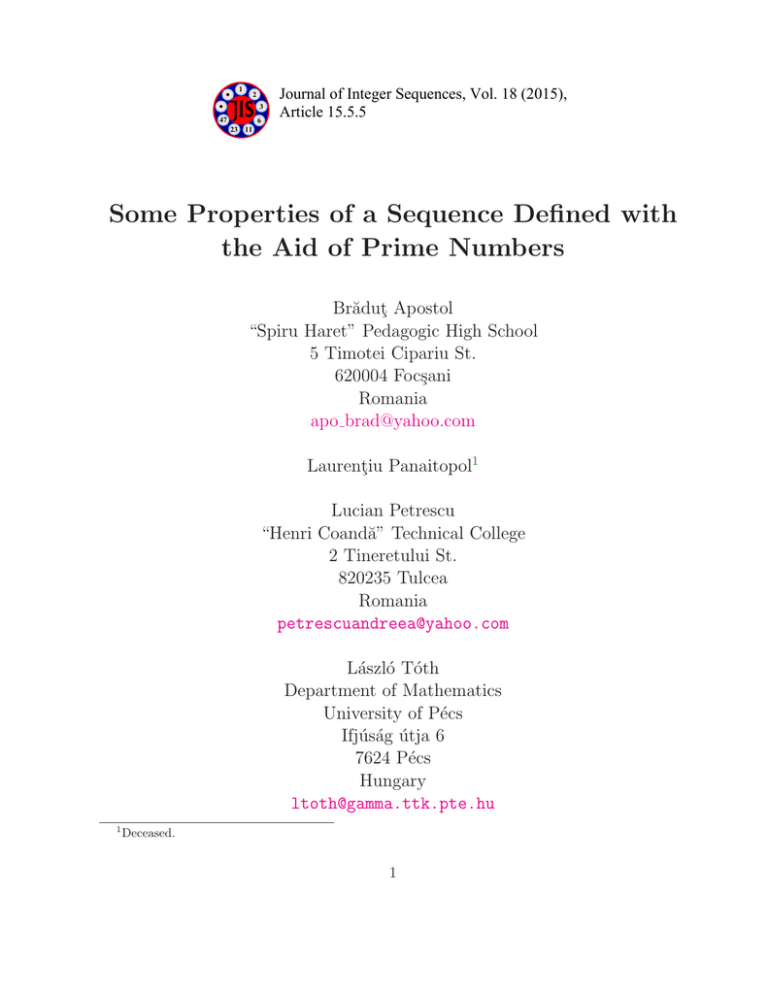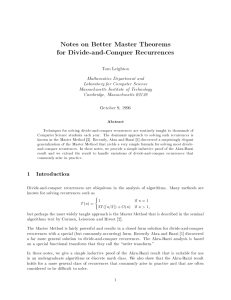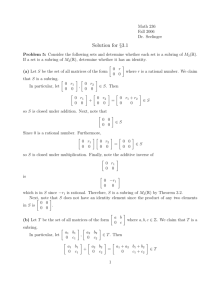Some Properties of a Sequence Defined with
advertisement

1
2
3
47
6
Journal of Integer Sequences, Vol. 18 (2015),
Article 15.5.5
23 11
Some Properties of a Sequence Defined with
the Aid of Prime Numbers
Brăduţ Apostol
“Spiru Haret” Pedagogic High School
5 Timotei Cipariu St.
620004 Focşani
Romania
apo brad@yahoo.com
Laurenţiu Panaitopol1
Lucian Petrescu
“Henri Coandă” Technical College
2 Tineretului St.
820235 Tulcea
Romania
petrescuandreea@yahoo.com
László Tóth
Department of Mathematics
University of Pécs
Ifjúság útja 6
7624 Pécs
Hungary
ltoth@gamma.ttk.pte.hu
1
Deceased.
1
Abstract
For every integer n ≥ 1 let an be the smallest positive integer such that n + an
is prime. We investigate
of the sequence
(an )n≥1 , and prove asymptotic
P
P
P the behavior
results for the sums n≤x an , n≤x 1/an , and n≤x log an .
1
Introduction
For every integer n ≥ 1 let an be the smallest positive integer such that n + an is prime.
Here a1 = 1, a2 = 1, a3 = 2, a4 = 1, a5 = 2, a6 = 1, a7 = 4, etc. This is sequence A013632 in
Sloane’s Online Encyclopedia of Integer Sequences [4]. For n ≥ 2, an is the smallest positive
integer such that gcd(n!, n + an ) = 1. In this paperPwe studyP
the behavior ofPthe sequence
(an )n≥1 , and prove asymptotic results for the sums n≤x an , n≤x 1/an and n≤x log an .
We are going to use the following standard notation:
• π(x) is the number of primes ≤ x,
• π2 (x) is the number of twin primes p, p + 2 such that p ≤ x,
• pn is the n-th prime,
• dn = pn+1 − pn ,
• f (x) ≪ g(x) means that |f (x)| ≤ Cg(x), where C is an absolute constant,
• g(x) ≫ f (x) means that f (x) ≪ g(x),
• f (x) = F (x) + O(g(x)) means that f (x) − F (x) ≪ g(x),
• f (x) ≍ g(x) means that cf (x) ≤ g(x) ≤ Cf (x) for some positive absolute constants c
and C,
• f (x) ∼ g(x) means that limx→∞ f (x)/g(x) = 1.
We will apply the following known asymptotic results concerning the distribution of the
primes:
x
π(x) ∼
, pn ∼ n log n (Prime number theorem),
log x
X
(1)
d2n ≪ x23/18+ε for every ε > 0 (unconditional result of Heath-Brown [1]),
pn ≤x
X
d2n ≪ x(log x)3
(assuming the Riemann hypothesis, result of Selberg [3]),
(2)
pn ≤x
d2 d3 · · · dn
(log 2)(log 3) · · · (log n)
1/n
≍ 1 (due to Panaitopol [2, Prop. 3]).
(3)
This research was initiated by Laurenţiu Panaitopol (1940–2008), former professor at the
Faculty of Mathematics, University of Bucharest, Romania. The present paper is dedicated
to his memory.
2
2
Equations and identities
By the definition of an , for every n ≥ 1 we have n + an = pπ(n)+1 , that is
an = pπ(n)+1 − n.
(4)
From (4) we deduce that for every k ≥ 1,
apk = pk+1 − pk , apk +1 = pk+1 − pk − 1, . . . , apk+1 −1 = 1.
(5)
Proposition 1. For every integer a ≥ 1 the equation an = a has infinitely many solutions.
Proof. Let Ak = {1, 2, . . . , pk+1 − pk }. Since lim supk→∞ (pk+1 − pk ) = ∞, it follows from (5)
that for every integer a ≥ 1 there exist infinitely many integers k ≥ 1 such that a ∈ Ak ,
whence the equation an = a has infinitely many solutions.
Now we compute the sum Sn =
n
X
ai .
i=1
Proposition 2. For every prime n ≥ 3 we have
π(n)−1
X
1
Sn = 2pπ(n)+1 − pπ(n) +
d2k ,
2
k=1
(6)
and for every composite number n ≥ 4,
π(n)−1
X
1
d2k − n2 − n .
Sn = p2π(n) + 2(n + 1 − pπ(n) )pπ(n)+1 +
2
k=1
Proof. If n ≥ 3 is a prime, then n = pm for some m ≥ 2. By using (4),
Sn =
n
X
pπ(i)+1 − i
i=1
= 2 + 3 + (5 + 5) + · · · + (pm − pm−1 )pm + pm+1 −
=2+
m
X
pk (pk − pk−1 ) + pm+1 −
k=2
1
=
2
1
=
2
p21 + 2
m
X
p2k − 2
k=2
2pm+1 − n +
m
X
n(n + 1)
2
pk pk−1 + 2pm+1 − n2 − n
k=2
m−1
X
n(n + 1)
2
(pk+1 − pk )2
k=1
3
!
!
(7)
and (6) follows by using that m = π(n).
Now let t ≥ 4 be composite. Let m ≥ 2 be such that pm < t < pm+1 . By applying (6)
for n = pm , where m = π(n) = π(t), we deduce
St = Sn +
t
X
ai = S n +
i=n+1
t
X
pπ(i)+1 − i
i=n+1
π(t)−1
(2pπ(t)+1 − n − t − 1)(t − n)
1
(pk+1 − pk )2 +
2pπ(t)+1 − pπ(t) +
2
2
k=1
π(t)−1
X
1
(pk+1 − pk )2 + 2pπ(t)+1 (t − n) − t2 − t + n2 + n
= 2pπ(t)+1 − pπ(t) +
2
k=1
π(t)−1
X
1
= p2π(t) + 2(t + 1 − pπ(t) )pπ(t)+1 +
(pk+1 − pk )2 − t2 − t
2
k=1
=
X
and (7) is proved.
Remark 3. If n is prime, then (7) reduces to (6). Therefore, the identity (7) holds for every
integer n ≥ 3.
n
Y
Next we compute the product Pn =
ai .
i=1
Proposition 4. For every prime n ≥ 3 we have
π(n)−1
Pn−1 =
Y
dk !,
(8)
k=1
and for every composite number n ≥ 4,
n−pπ(n)
π(n)−1
Pn−1 =
Y
dk !
k=1
Y
(pπ(n)+1 − pπ(n) − k + 1).
k=1
Proof. Let n = pm ≥ 3 be a prime. By using (5),
Pn−1 =
m
Y
(pi − pi−1 )! =
i=2
m−1
Y
(pi+1 − pi )!,
i=1
which proves (8).
4
(9)
Now let t ≥ 4 be composite such that pm < t < pm+1 . By applying (8) for n = pm , where
m = π(n) = π(t), we deduce
Pt−1 = Pn−1
t−1
Y
ai = Pn−1
i=n
π(t)−1
=
Y
dk !
Y
dk !
pπ(i)+1 − i
i=n
t−pm
Y
(pm+1 − pm − j + 1)
j=1
k=1
t−pπ(t)
π(t)−1
=
t−1
Y
k=1
Y
pπ(t)+1 − pπ(t) − k + 1
k=1
and (9) is proved.
Remark 5. If n is prime, then the second product in (9) is empty and (9) reduces to (8).
Hence the identity (9) holds for every integer n ≥ 3.
3
Asymptotic results
Theorem 6. For every ε > 0,
x log x ≪
X
an ≪ x23/18+ε ,
(10)
n≤x
.
where 23/18 = 1.277. If the Riemann hypothesis is true, then the upper bound in (10) is
x(log x)3 .
Proof. Let x ≥ 2 and let pk ≤ x < pk+1 . By using (6) for n = pk+1 ,
!
pk+1
k
X
X
X
1
2pk+2 − pk+1 +
d2i
an ≤
ai =
2
i=1
i=1
n≤x
X
2
≪ pk+2 +
di .
pi ≤x
Taking into account the estimate (1) due to Heath-Brown, and the fact that pk+2 ∼ pk ≤ x
we get the unconditional upper bound in (10). If the Riemann hypothesis is true, then by
using Selberg’s result (2) we obtain the upper bound x(log x)3 .
Now, for the lower bound we use the trivial estimate
X
d2n ≫ x log x,
pn ≤x
5
which follows from the inequality between the arithmetic and quadratic means. We deduce
that
!
pk
k−1
X
X
X
1
2pk+1 − pk +
d2i
ai =
an ≥
2
i=1
i=1
n≤x
X
≫
d2i ≫ pk−1 log pk−1 ∼ x log x,
pi ≤pk−1
since pk−1 ∼ k log k and k = π(x) ∼ x/ log x, log k ∼ log x.
To prove our next result we need the following
Lemma 7. We have
X
log dn = x log log x + O(x).
(11)
2≤n≤x
Proof. The inequalities (3) can be written as
cn <
n
X
i=2
log di −
n
X
log log i < Cn
i=2
for some positive absolute constants c and C. Now (11) emerges by applying the well known
asymptotic formula
X
log log n = x log log x + O(x).
2≤n≤x
Theorem 8. We have
X 1
x log log x
x
.
+O
=
a
log x
log x
n≤x n
(12)
Proof. For x = pm − 1 (m ≥ 2) we have by (5),
m X 1
X
1
1
.
=1+
1 + + ··· +
a
2
pi − pi−1
i=2
n≤p −1 n
m
For an arbitrary x ≥ 3 let pk (k ≥ 2) be the prime such that pk ≤ x < pk+1 . Using the
familiar inequalities
log m < 1 +
1
1
+ ··· +
≤ 1 + log m (m ≥ 1)
2
m
we deduce
log(pi − pi−1 ) < 1 +
1
1
+ ··· +
≤ 1 + log(pi − pi−1 ) (i ≥ 2)
2
pi − pi−1
6
and
1+
k
X
X 1
1
1
<
+
dk n≤p −1 an apk
log(pi − pi−1 ) +
i=2
k
k+1
X 1
X
X 1
≤
≤1+k+
log(pi − pi−1 ).
≤
a
a
i=2
n≤p
−1 n
n≤x n
k+1
By (11) we obtain
X 1
= k log log k + O(k),
a
n
n≤x
Here k = π(x) ∼ x/ log x, log k ∼ log x and we deduce (12).
Theorem 9. One has
x≪
X
log an ≪ x log x.
n≤x
Proof. For an arbitrary x ≥ 3 let pk (k ≥ 2) be the prime such that pk ≤ x < pk+1 . Using
the elementary inequalities
m log m − m + 1 ≤ log m! ≤ m log m (m ≥ 1)
we deduce by applying (8) that
X
log an ≤
n≤x
X
log an =
k
X
log di ! ≤
i=1
n≤pk+1 −1
<
k
X
di log pi < (log pk )
i=1
k
X
k
X
di log di
i=1
di < (log pk )pk+1 ,
i=1
where we also used that di = pi+1 − pi < pi by Chebyshev’s theorem. Here
pk ∼ k log k,
k = π(x) ∼ x/ log x,
log k ∼ log x,
and we obtain the upper bound x log x.
On the other hand,
X
n≤x
>
k−1
X
log an >
X
log an =
(di log di − di + 1) =
k−1
X
i=2
7
log di !
i=1
n≤pk −1
i=1
k−1
X
di log di − pk + k + 1.
(13)
Here
k−1
X
i=2
di log di =
k−1
X
di log di + 2 log 2
k−1
X
1
i=2
di =2
i=2
di ≥3
≥ (log 3)
k−1
X
di + (2 log 2)π2 (k − 1)
i=2
d ≥3
i
k−1
k−1
X
X
di + (2 log 2)π2 (k − 1)
= (log 3)
di −
i=2
i=2
di =2
= (log 3) (pk − p2 − 2π2 (k − 1)) + (2 log 2)π2 (k − 1)
= (log 3)pk − 2 log(3/2)π2 (k − 1) − 3 log 3
> (log 3)pk − 2 log(3/2)k − 3 log 3,
.
where it is sufficient to use the obvious estimate π2 (k − 1) < k. Note that log 3 = 1.09,
.
.
2 log(3/2) = 0.81, 3 log 3 = 3.29.
We deduce that
X
log an > 0.09pk − 3.
n≤x
Now (13) gives the lower bound x.
References
[1] D. R. Heath–Brown, The differences between consecutive primes, III, J. London Math.
Soc. (2) 20 (1979), 177–178.
[2] L. Panaitopol, Properties of the series of differences of prime numbers, Publ. Centre de
Rech. Math. Pures Neuchâtel (Serie 1) 31 (2000), 21–28.
[3] A. Selberg, On the normal density of primes in small intervals, and the difference between
consecutive primes, Arch. Math. Naturvid. 47 (1943), No. 6, 87–105.
[4] N. J. A. Sloane, The On-Line Encyclopedia of Integer Sequences. http://oeis.org.
2010 Mathematics Subject Classification: Primary 11A41; Secondary 11N05.
Keywords: prime numbers, difference of consecutive primes, asymptotic behavior.
(Concerned with sequences A000040, A001223, A013632, and A076821.)
8
Received March 3 2015; revised version received April 3 2015. Published in Journal of Integer
Sequences, May 21 2015.
Return to Journal of Integer Sequences home page.
9



